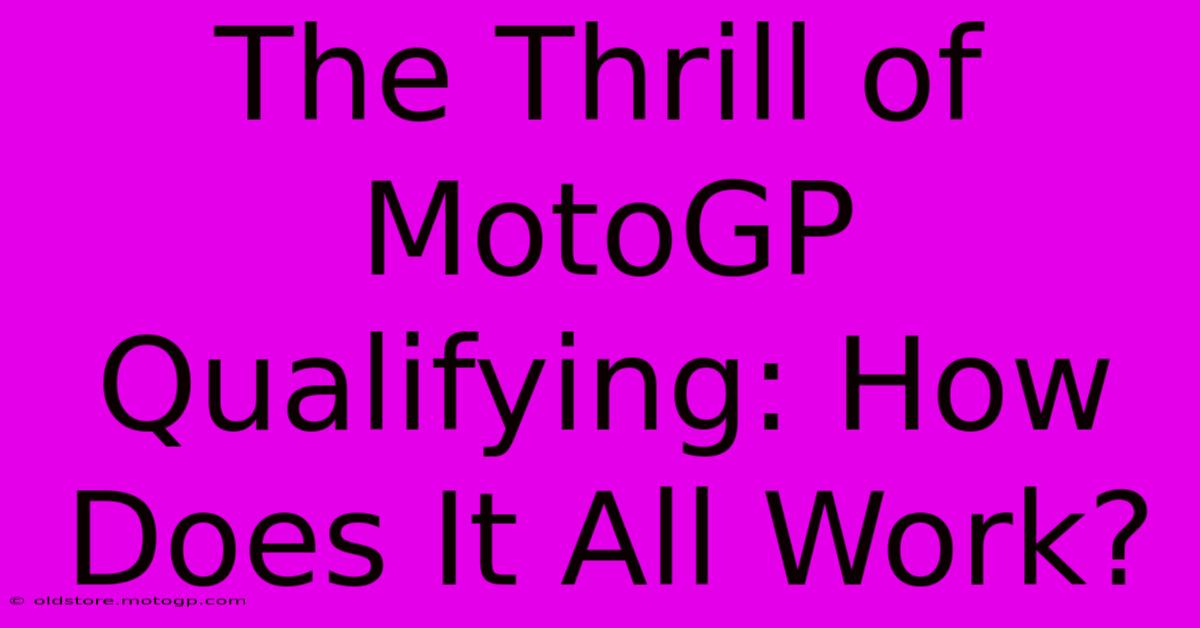The Thrill Of MotoGP Qualifying: How Does It All Work?

Table of Contents
The Thrill of MotoGP Qualifying: How Does It All Work?
The roar of the engines, the smell of burning rubber, the sheer, breathtaking speed – MotoGP is a spectacle unlike any other. But before the lights go out on race day, there's another crucial event that determines grid positions and sets the stage for potential drama: qualifying. Understanding how MotoGP qualifying works is key to appreciating the intensity and strategy behind this crucial part of the weekend.
Understanding the Qualifying Format
MotoGP qualifying isn't a simple time trial. It's a multi-stage process designed to weed out the slower riders and highlight the skill of the fastest. The current format involves two qualifying sessions: Q1 and Q2.
Q1: The Fight for Q2
This is where the battle begins. The ten slowest riders from the combined Free Practice sessions (FP1, FP2, and FP3) are relegated to Q1. They have a limited time – typically 15 minutes – to fight for their place in Q2. Only the two fastest riders from Q1 earn their spot in the decisive Q2 session. The pressure is immense, and even small mistakes can be costly. This session is a brutal elimination round, showcasing incredible riding skill under pressure.
Q2: The Showdown for Pole Position
The top 10 riders from the combined Free Practice sessions automatically advance to Q2. This is where the real fireworks happen. These are the fastest riders on the grid, and they have 15 minutes to set the fastest lap time possible. The rider with the fastest lap at the end of Q2 earns the coveted pole position, securing the most advantageous starting spot for the race. This position offers a significant advantage, often influencing the race outcome. The remaining nine riders fill the remaining front grid positions.
The Importance of Qualifying
Qualifying isn't just about bragging rights for pole position. It's strategically crucial for several reasons:
- Starting Position Advantage: A front-row start gives riders a significant head start and better racing lines, reducing the risk of being caught in early-race chaos. This is particularly important on tracks with limited overtaking opportunities.
- Race Strategy: Qualifying performance influences race strategies. A rider starting from pole might opt for a conservative race strategy to maintain their lead, while someone further back might adopt a more aggressive approach.
- Team Morale: A strong qualifying performance boosts team morale and confidence going into the race. It shows that the team has made the right setup choices and that the rider is in top form.
- Championship Points: While not as many points as a race win, securing a good qualifying position translates to valuable points in the championship standings.
Beyond the Times: Factors Influencing Qualifying
While pure speed is essential, several other factors can significantly impact a rider's qualifying performance:
- Track Conditions: Weather, temperature, and track surface grip dramatically influence lap times. Adapting quickly to changing conditions is a key skill.
- Tire Choice: Choosing the right tire compound for qualifying is critical. A slightly slower tire that provides better consistency might be preferred over a faster tire that wears out quickly.
- Bike Setup: Fine-tuning the bike's settings is crucial for optimizing its performance over a single flying lap. Experienced mechanics play a vital role in this process.
- Slipstream: Taking advantage of the slipstream from another rider's bike can provide a significant speed boost, particularly on straights. It is a key tactic employed by many riders, especially during the final minutes of Q2.
The Thrill of the Chase
MotoGP qualifying is a high-stakes, fast-paced event that offers intense drama and excitement. The battle for pole position is a captivating display of skill, precision, and strategy, setting the stage for what promises to be an exhilarating race. Understanding the intricacies of the qualifying format allows you to fully appreciate the skill and pressure involved, adding another layer of enjoyment to the MotoGP experience. So next time you watch MotoGP, remember that the thrill doesn't just begin on race day, it starts with the nail-biting tension of qualifying.

Thank you for visiting our website wich cover about The Thrill Of MotoGP Qualifying: How Does It All Work?. We hope the information provided has been useful to you. Feel free to contact us if you have any questions or need further assistance. See you next time and dont miss to bookmark.
Featured Posts
-
Experience The Thrill Of Moto Gp The Ultimate Arcade Game
Feb 18, 2025
-
Rare Find Moto Gp Machine Awaits A True Enthusiast
Feb 18, 2025
-
Moto Gp Sprint Races A Spectators Dream
Feb 18, 2025
-
Us Gp Concerts A Must See Event
Feb 18, 2025
-
Skip The Taxi Line Choose The F1 Shuttle
Feb 18, 2025
